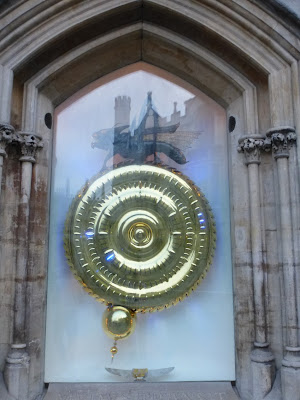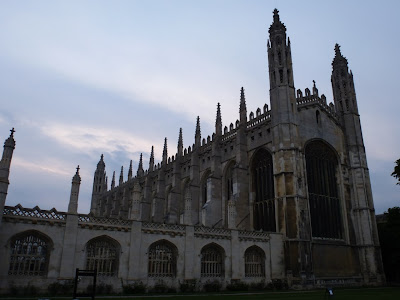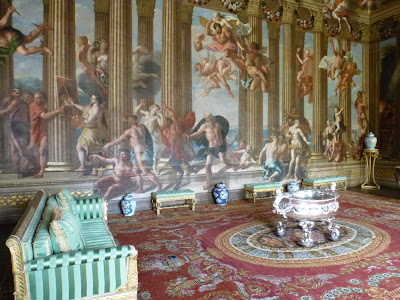Where we were going next turned out to be London, its southeast suburb of Bexleyheath, across the Docklands, east London, the Blackwall Tunnel, to Red House, the only house designed, built, and lived in by Arts and Crafts Movement guru William Morris. (Think Art Nouveau). He built it in 1860, just after his wedding and a honeymoon in France and was assisted by architect Philip Webb and artist Edward Burne-Jones. He sold it in 1865, never returned, but the house has remained a Mecca for artsy/craftsy types.
 |
| Red House entrance |
 |
| Much interesting stained and painted glass |
 |
| Thus |
 |
And thus, the front door; there is much Morrisiana
throughout the house, much of it later stuff, but there
is also much by Burne-Jones, other friends, and later
occupants of the house |
 |
| The downstairs settle |
 |
Up close; it is said that Morris came to grief over this painting and his perceived
inability to represent the human figure; and thus decided not to become a painter |
 |
Nice touch department: on panes in a door near the entry visitors scratched their
names; look closely and you will see A. Lasenby Liberty, of Regent Street
department store fame; Art Nouveau is known as "Liberty" in some other parts
of the world |
 |
| Main floor view |
 |
| Staircase ceiling |
 |
The master bedroom settle, leading to a loft and the attic, flanked by Burne-Jones'
paintings |
 |
The Red House came to the National Trust only a few years ago, and every
time they do repair or restoration something new and unknown pops up; here,
a floral design under ceiling slats; scratch tests are ongoing throughout the
house |
 |
| Upstairs hallway |
 |
Just discovered department: this mural, presumably by Burne-Jones, was just
uncovered a few months back |
 |
| One of two original Morris print blocks on display at the house |
 |
| Thus (on the wall) |
 |
| A Morris tapestry |
 |
Back yard view; the whole thing was set in what had been an apple orchard, and
several ancient trees remained; Morris' garden was among the first to incorporate
a "room" design (herb room, vegetable room, flower room, etc.) which we have
seen elsewhere |
 |
Vicki taught at Bexley High School, a suburb of Columbus, Ohio,
and we lived in Bexley for a few years...our first house; daughter
Rebecca was born in those days and spent her first few years on
Bellwood Avenue, Bexley, Ohio |



























































